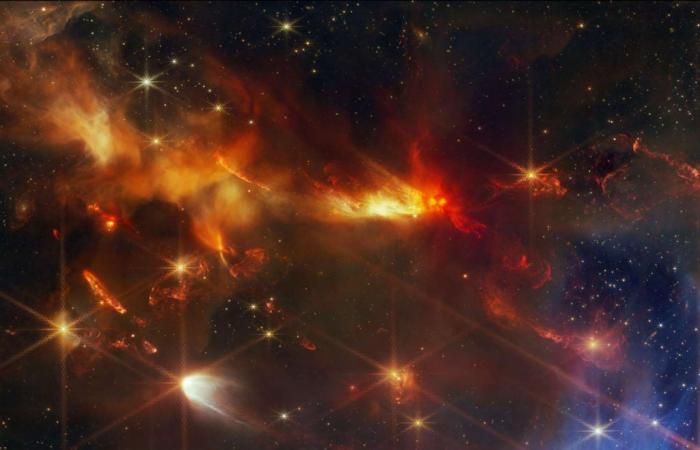NASA and ESA have just revealed new images taken by the near infrared cameranear infrared camera (NIRCam) of the James-Webb space telescope in a press release which accompanies a publication in The Astrophysical Journal. It is about an astonishing phenomenon that the JWSTJWST uncovered by studying a star forming region in the Milky Way, known as the nebulanebula du Serpent, more precisely in the northern part of this young region containing protostarsprotostars growing and even those that have already become stars on the main sequencemain sequenceas the people say astrophysicistsastrophysicists in their jargon – that is to say whose core has become hot enough for thermonuclear reactions of mergermerger have just started recently.
We know that these young objects observed elsewhere in our GalaxyGalaxy produce bipolar jets of mattermatter but, curiously, in the JWST observations we now see in the northern region of the Serpent Nebula that several of these jets are almost parallel.
An enigma for stellar cosmogony?
In fact, this is the first observation of one of the predictions of modern theory of the birth of stars and protoplanetary disksprotoplanetary disks surrounding them. This phenomenon is therefore not really a surprise. We are only discovering it today, because NIRCam allows observations at resolutionsresolutions never before seen in the near infrared, revealing finer and smaller details than before with other space telescopes, for example the defunct Spitzer.
To understand what this is all about, a few reminders of planetary cosmogony are necessary. The first drafts of a modern scientific theory on this subject are due to Kant and Laplace.
According to them, the Solar systemSolar system comes from thecollapsecollapse of a cloudcloud of gasgas and rotating dust. There centrifugal forcecentrifugal force perpendicular to the axis of rotation opposing the contraction of this cloud, it flattens thus forming a protoplanetary disk where the dust agglomerates into pebbles which, themselves, will end up forming embryosembryos of planets – for short. The scenario was considerably refined during the second half of the 20th century.e century and the beginning of the 21ste.
Sean Raymond, astrophysicist at the Bordeaux Astrophysics Laboratory, talks to us about the formation of the Solar System according to the standard scenario by accretion of planetesimals giving rise to planetary embryos. © Ideas in Science
One of the key points to keep in mind: one of the fundamental laws of Newton’s mechanicsNewton’s mechanicsthat known as the conservation of cinematic momentcinematic moment. When a rotating body contracts, like a skater bringing her arms together, it leads to an increase in its rotation speedrotation speed and vice versa.
In the case of SunSunthis one, which nevertheless contains the majority of the massmass of the Solar System, rotates much more slowly than expected. There therefore existed a mechanism which ejected part of the initial angular momentum of the protosolar cloud.
We have theories about the mechanisms involved. First, by contracting like a compressed gas, this cloud heated up to the point that part of the matter was ionized, therefore producing electric currentselectric currentsthen magnetic fieldsmagnetic fields. The cloud itself must have initially contained them because we know that our Milky Way is covered with them.
A magnetized filament where stars are born
Calculations and simulations then show that magnetic fields influence not only the contraction of the cloud, but also its rotation and therefore ultimately that of a protostar forming in its core by gravitational collapse. Magnetic field lines are then found in connection with the movementsmovements of matter, for example that of rotation of the protoplanetary disk and its young star by slowing down its rotation. However, angular momentum must always be dissipated, and this is what the appearance of a bipolar jet will do, carrying matter in swirling motion around the axis of the jets.
This enlarged video shows the relative position of the Serpent Nebula in the sky. It begins with a photo taken on the ground by the late astrophotographer Akira Fujii, then moves to an image of the Digitized Sky Survey. Next, an image from NASA’s Spitzer Space Telescope appears, and finally the video comes to the image of the Serpent taken by NASA’s James Webb Space Telescope, ESA, CSA. © NASA, ESA, CSA, A. Pagan (STScI) Acknowledgments: Akira Fujii, Digitized Sky Survey, Spitzer Space Telescope
While until now we had only observed stars in the process of formation coming almost at the same time from a cloud of matter collapsing and fragmenting into individual stars or forming multiple systems, it was predicted that the state of rotation of matter on a smaller scale in this cloud could lead to groups of stars whose axes of rotation were almost parallel.
In the JWST observations, we also see that stars with parallel bipolar jets also have these aligned with the axis of a filament of gas and dust containing the star-forming region of the Serpent Nebula, its axis -even determined by magnetic field lines.
For astrophysicists, this is ultimately the first proof that stars born at the same time in a cloud of matter can indeed, as predicted by the models, have axes of rotation fixed by the overall rotation of the cloud. , which is also related to galactic magnetic fields.
The Serpent Nebula observed
The Serpent Nebula is only one or two million years old, which is very young in cosmic terms. It also hosts a particularly dense cluster of newly formed stars (about 100,000 years old) at the center of this image, some of which will eventually reach the mass of our Sun.
The Serpent is a reflection nebula, which means it is a cloud of gas and dust that does not create its own lightlightbut shines by reflecting light from nearby stars or within the nebula.
Thus, throughout the region of this image, filaments and swirls of different hues represent starlight reflected by protostars still forming in the cloud. In some areas there is dust in front of this reflection, which appears here in a diffuse orange hue.
This region has been the scene of other chance discoveries, notably the shadow of the batbat which beats, and which owes its name to the 2020 observations of Hubble space telescopeHubble space telescope from NASA-ESA, which revealed that it was “beating” or moving. This feature is visible in the center of Webb’s image.
A summary of the discovery. © NASA, ESA, CSA, STScI, K. Pontoppidan (NASA’s Jet Propulsion Laboratory), J. Green (Space Telescope Science Institute)






